Orange King Barberry Berberis trigona 'Orange King'

ABOUT
The 'Orange King' Barberry is a visually striking shrub known for its vibrant foliage and striking coloration. This particular variety sports leaves that boast a bright, fiery orange hue which can add a warm splash of color to any garden space. As seasons change, the leaves might take on different tones, transitioning through shades of yellow, gold, and red, creating a dynamic and seasonal display. The plant exhibits a dense, multi-stemmed habit, with branches that grow both upright and outward, lending itself to a somewhat rounded form. The stems of the 'Orange King' Barberry are adorned with thorns, making the shrub a good choice for barriers or defensive plantings. These thorns also add a textural element to the plant's appearance. The small leaves are typically oval to spatula-shaped, clustering along the thorny branches, and produce a lush, full look throughout the growing season. In springtime, this barberry variety may produce tiny, yellow flowers that add another level of decorative appeal. Though the flowers are not particularly large or showy, they do contrast nicely with the bright orange foliage. Following the flowering period, the plant may bear small, bluish-black berries that attract birds and wildlife, although they are not considered edible for humans. Overall, the 'Orange King' Barberry is cherished in landscaping for its compact and vivid foliage which gives gardeners the ability to create focal points or to enhance the aesthetic appeal of mixed borders and foundation plantings without the need to rely on floral blooms. Its resilience and easy-care nature make it a popular choice for a variety of garden settings.
About this plant
 Names
NamesSynonyms
Orange King Barberry
Common names
Berberis trigona 'Orange King'.
 Toxicity
ToxicityTo humans
Berberis trigona 'Orange King', commonly known as Barberry, is generally considered non-toxic to humans. However, consuming large quantities of the berries may cause mild stomach upset in some individuals.
To pets
Barberry is also generally considered non-toxic to pets. Similar to humans, ingestion of large amounts of the plant, particularly the berries, may cause mild digestive upset in some pets, but it is not known to be a common cause of serious poisoning.
 Characteristics
CharacteristicsLife cycle
Perennials
Foliage type
Evergreen
Color of leaves
Green
Height
3 feet (0.91 meters)
Spread
2 feet (0.61 meters)
Plant type
Shrub
Hardiness zones
7
Native area
South America
Benefits
 General Benefits
General Benefits- Attractive Foliage: Berberis trigona 'Orange King' is prized for its vibrant orange-colored leaves, which add a splash of color to any garden.
- Seasonal Interest: This Berberis variety provides year-round interest with foliage changes throughout the seasons and occasional bright red berries.
- Drought Tolerance: Once established, it is quite drought-resistant, making it ideal for water-wise landscapes.
- Low Maintenance: This plant requires minimal care, making it suitable for gardeners of all skill levels.
- Wildlife Attraction: The flowers and berries can attract birds and beneficial insects to the garden.
- Dense Growth Habit: Its dense and compact growth habit makes it an excellent choice for hedges and privacy screens.
- Adaptability: It can adapt to a wide range of soil types and conditions, making it versatile for various garden settings.
- Defensive Planting: With thorny branches, it can be used as a barrier plant to deter unwanted foot traffic or animal intrusion.
 Medical Properties
Medical PropertiesThis plant is not used for medical purposes.
 Air-purifying Qualities
Air-purifying QualitiesThis plant is not specifically known for air purifying qualities.
 Other Uses
Other Uses- Berberis trigona 'Orange King', as a hedging plant, can be used to create intricate maze gardens or privacy barriers in landscaping.
- The thorny branches of the plant can be incorporated into living fences to deter wildlife and intruders from entering certain areas.
- The dense foliage can provide a microclimate for smaller plants, offering them shade and protection from the wind.
- Vibrant orange flowers can be used in cut flower arrangements for a bold splash of color, even though they don't typically last long.
- The plant can be trained into topiary forms, with its stiff branches making it suitable for shaping into various ornamental designs.
- Photographers might use the plant as a backdrop in portrait photography because of its striking foliage and flower color.
- Its branches can be used in crafts or as natural supports for climbing plants in the garden.
- During autumn, the colored leaves can be collected and used in decorative projects like wreaths or table centerpieces.
- The plant can serve as a natural windbreak for smaller, more delicate plants in the garden that require shelter from strong winds.
- The bark of the Berberis trigona 'Orange King' can be used to create a unique, naturally textured mulch for garden beds.
Interesting Facts
 Feng Shui
Feng ShuiThe Barberry plant is not used in Feng Shui practice.
 Zodiac Sign Compitability
Zodiac Sign CompitabilityThe Barberry plant is not used in astrology practice.
 Plant Symbolism
Plant Symbolism- Protection: Berberis, commonly known as Barberry, often has sharp thorns, which historically has associated it with protection and setting boundaries.
- Purification: Barberry has been used in traditional medicine to detoxify the body, symbolizing cleansing and purification.
- Sharpness: The thorns of the Barberry also represent mental sharpness, wit, and insight.
- Adaptability: Barberry's ability to grow in various conditions symbolizes adaptability and resilience in different life situations.
 Water
WaterFor the Japanese barberry, water deeply once every week during dry periods, ensuring that the soil is sufficiently moistened. If the weather is particularly hot or windy, check the soil more often as it may require additional water. Aim to provide about 1 to 1.5 gallons depending on the plant size and environmental conditions, which is enough to soak the root zone without causing waterlogging. During the rainy season or cooler months, reduce watering frequency to prevent overwatering. Always allow the top inch of soil to dry out before watering again to promote healthy root development.
 Light
LightJapanese barberry thrives best in full sun to partial shade conditions. It should be placed in a location where it can receive at least six hours of direct sunlight daily, although it can tolerate some light dappled shade, particularly in hotter climates. Avoid deep shade, as this can reduce the vibrancy of the foliage and may lead to a less robust plant.
 Temperature
TemperatureJapanese barberry is quite hardy and can survive a range of temperatures, typically from about -30°F to 100°F. It thrives best when the temperature is between 60°F and 70°F. Ensure that the plant is well-watered during extreme heat to prevent stress.
 Pruning
PruningPrune Japanese barberry annually in late winter or early spring to maintain its shape and encourage healthy growth. Pruning stimulates new growth, removes any dead or diseased branches, and allows light and air to penetrate into the center of the plant. Prune before new growth starts and be sure to wear gloves due to the thorns.
 Cleaning
CleaningAs needed
 Soil
SoilBarberry 'Orange King' prefers well-drained soil enriched with organic matter such as compost or peat moss. A slightly acidic to neutral pH of 6.0 to 7.5 is ideal for this plant. For the best soil mix, combine two parts garden soil, one part peat moss or compost, and one part perlite or coarse sand to ensure proper drainage and aeration.
 Repotting
RepottingBarberry 'Orange King' does not need to be repotted frequently and can thrive in the same pot for several years. It should be repotted every 2-4 years or when you notice that the growth has slowed considerably, usually an indication that it is becoming root-bound.
 Humidity & Misting
Humidity & MistingBarberry 'Orange King' is tolerant of a wide range of humidity levels and does not require any special humidity conditions. Being adaptable, it can thrive in the ambient humidity found in most outdoor environments without the need for additional humidity adjustments.
 Suitable locations
Suitable locationsIndoor
Ensure bright light, well-drained soil, and moderate water.
Outdoor
Plant in sun to partial shade, in well-drained soil.
Hardiness zone
5-8 USDA
 Life cycle
Life cycleBerberis trigona 'Orange King', commonly known as Barberry, begins its life cycle with seed germination, which can occur in spring after a required period of cold stratification. Upon sprouting, the seedling establishes a root system and grows into a small shrub with spiny branches and characteristic deciduous leaves that are often brightly colored. During its vegetative growth stage, the Barberry invests energy in height and branch development to reach maturity, typically taking several years. As an adult plant, it produces clusters of small, yellow flowers in the springtime, which are pollinated by insects. Following pollination, the flowers develop into small, bright red berries that contain seeds; these berries can attract birds, which then disperse the seeds. The Barberry's lifecycle can span multiple decades, and it may experience periods of dormancy in winter, when it sheds leaves and conserves energy until the next growing season.
 Propogation
PropogationPropogation time
Spring to Summer
Propogation: The most popular method for propagating the Berberis trigona 'Orange King', commonly known as Barberry, is through softwood cuttings. This technique is typically employed in late spring to early summer when the plant’s new growth is still flexible but has started to harden slightly. To do this, a cutting of about 4 to 6 inches (approximately 10 to 15 cm) is taken, ensuring it has a few leaves but the lower leaf nodes are stripped. The cut end is usually dipped in rooting hormone powder to encourage root growth and then planted in a well-draining potting mix. Providing a warm environment and maintaining high humidity with a plastic cover can help improve the success rate, and roots usually develop within a few weeks. After rooting, the new plants are gradually acclimated to less humid conditions before transplanting them outdoors.

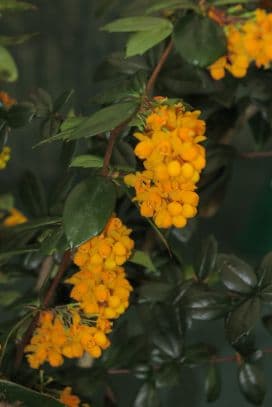
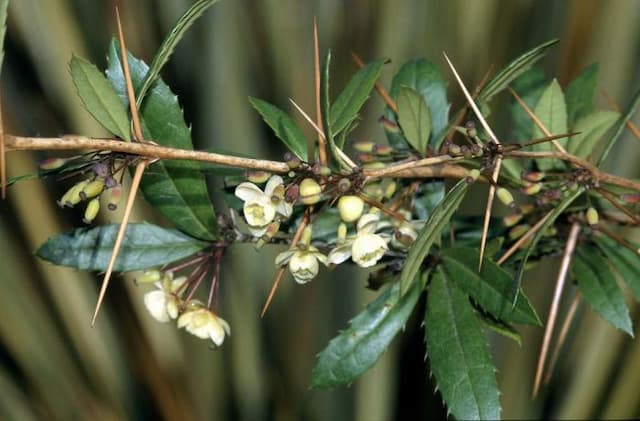
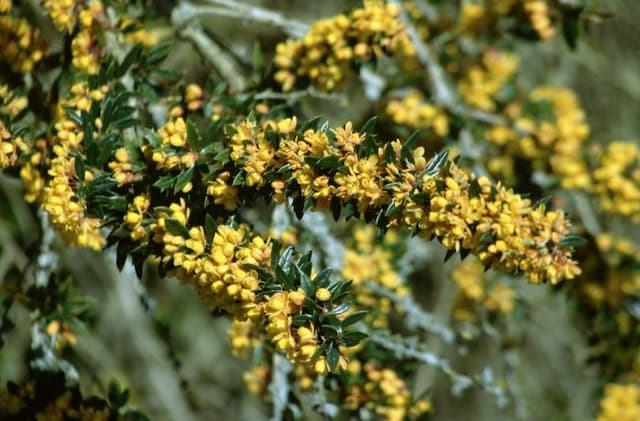
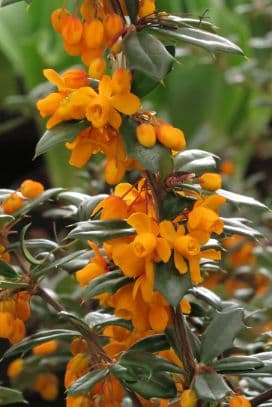
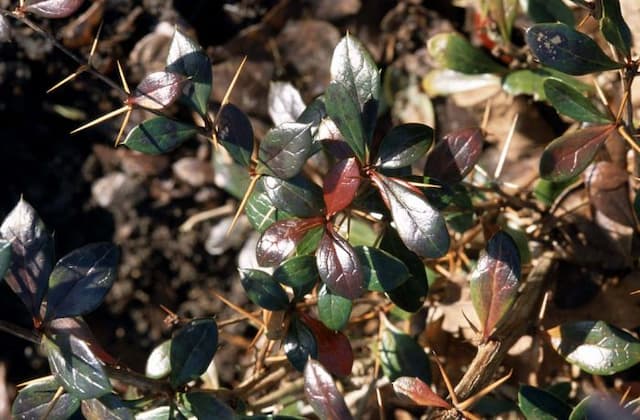


![Japanese barberry [Bonanza Gold]](/_next/image?url=https%3A%2F%2Fplants-admin.emdemapps.com%2Fimages%2Fplants%2F%2Fimages%2F604b5385e413f.png&w=640&q=75)
